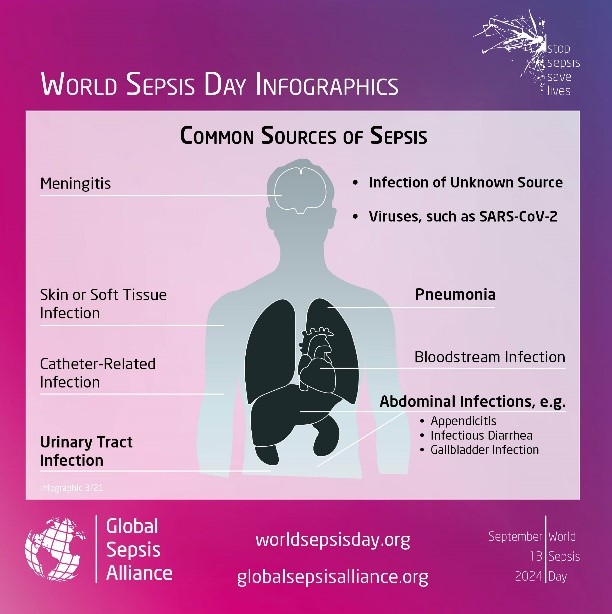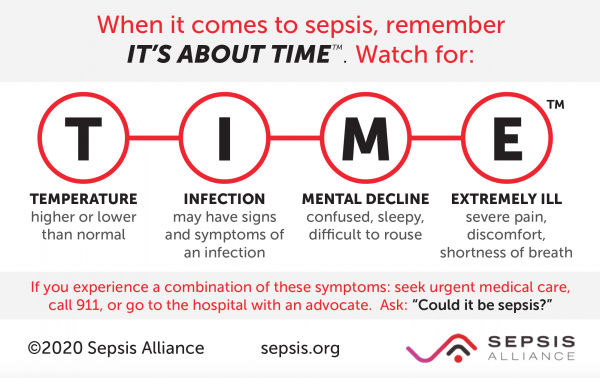August 23, 2024
Sepsis: A Silent and Deadly Threat
September 13th is World Sepsis Day, dedicated to raising awareness about this life-threatening condition. Sepsis arises when the body’s response to an infection causes damage to its own tissues and organs. This condition can lead to shock, multi-organ failure, and even death, particularly if it is not recognized and treated promptly. Sepsis is not a rare occurrence; it is a common cause of death worldwide. In the United States, it is the number one cause of death in hospitals and top reason for hospital readmissions.
The Global Impact of Sepsis
The numbers surrounding sepsis are staggering. Every year, there are an estimated 47 to 50 million cases of sepsis globally, and at least 11 million of these cases result in death. This means that one in five deaths worldwide is associated with sepsis. Even survivors often face long-term physical and psychological effects, with up to 50% experiencing lingering symptoms.

Who Is at Risk?
Sepsis can affect anyone, but certain groups are more vulnerable. This includes:
- Children: Nearly 40% of sepsis cases occur in children under the age of five.
- The Elderly: Older adults are at higher risk due to weaker immune systems and the increased likelihood of underlying health conditions.
- Those with Chronic Conditions: Individuals with chronic illnesses such as diabetes, lung disease, or cancer are more susceptible.
- Individuals with Weakened Immune Systems: This includes people undergoing chemotherapy, those with HIV/AIDS, and transplant recipients on immunosuppressive drugs.
Recognizing the Symptoms of Sepsis
Sepsis is a medical emergency, and every hour counts when it comes to treatment. Early recognition of the symptoms is crucial for survival. The signs of sepsis may include:
- Slurred Speech or Confusion: Mental confusion or an inability to think clearly can be an early warning sign.
- Extreme Shivering or Muscle Pain: A common symptom is unexplained severe muscle pain or shivering, often accompanied by fever.
- Passing No Urine (All Day): A decrease in urine output can indicate sepsis as the body starts to shut down.
- Severe Breathlessness: Difficulty breathing, or rapid breathing may signal that the body is not getting enough oxygen.
- It Feels Like You’re Going to Die: An overwhelming sense of impending doom can be a symptom of sepsis.
- Mottled or Discolored Skin: Changes in skin color, such as mottling or discoloration, can occur as blood flow to the skin decreases.

Maternal Sepsis
Maternal sepsis is a life-threatening condition that arises when an infection during pregnancy, childbirth, post-abortion, miscarriage, or the postpartum period leads to organ dysfunction. This condition is a leading cause of pregnancy-related deaths in the United States, underscoring the importance of early recognition and treatment.
Symptoms to watch for include
- fever above 100.4°F
- foul-smelling discharge
- difficulty breathing
- chest pain
- confusion
- general abdominal pain that worsens suddenly
Women with risk factors such as diabetes, mastitis, viral or bacterial infections (e.g., UTIs), or those who have had a cesarean section, prolonged labor, or emergency surgery are at a higher risk. If these symptoms are present, seeking emergency medical care and expressing concern about sepsis is crucial to ensure prompt treatment. Early intervention is key to saving lives and preventing severe complications.
What to Do If You Suspect Sepsis
If you or someone you know shows signs of sepsis, it is crucial to seek medical care immediately. Sepsis is always caused by an infection, such as pneumonia or a diarrheal illness, and can quickly escalate to a life-threatening condition. The faster sepsis is recognized and treated, the better the chances of survival.
Treatment for Sepsis
Treatment for sepsis typically involves hospitalization, where the patient will receive antibiotics and intravenous fluids. In severe cases, patients may require intensive care, including mechanical ventilation, dialysis, or other life-support measures. Early and aggressive treatment is essential to prevent further complications and improve outcomes.
Sepsis is a serious and deadly condition, but with awareness and prompt action, we can make a difference in saving lives.
To learn more about the care that Southern New Hampshire Health provides to our community, visit snhhealth.org.
For More Information about Sepsis:
